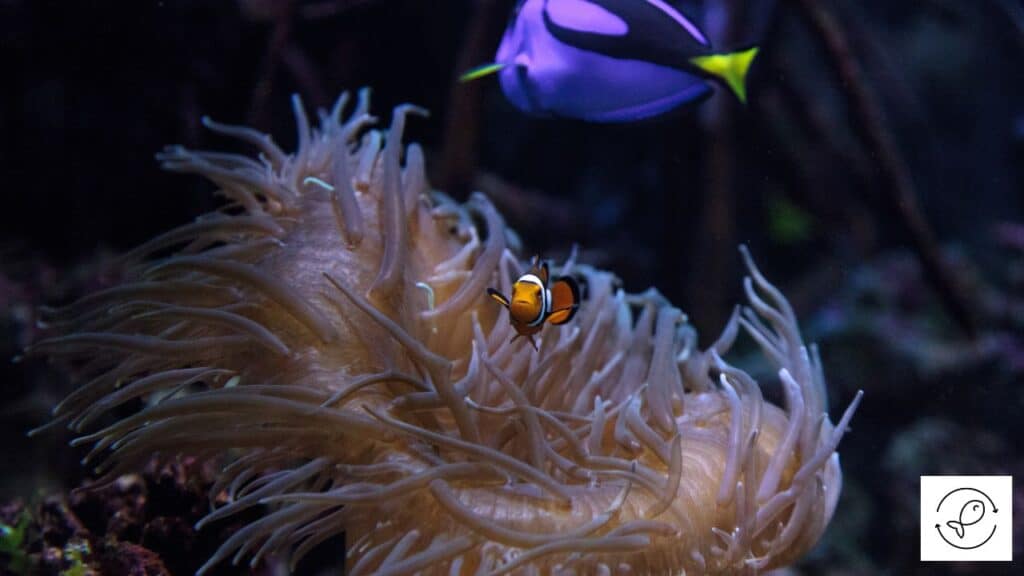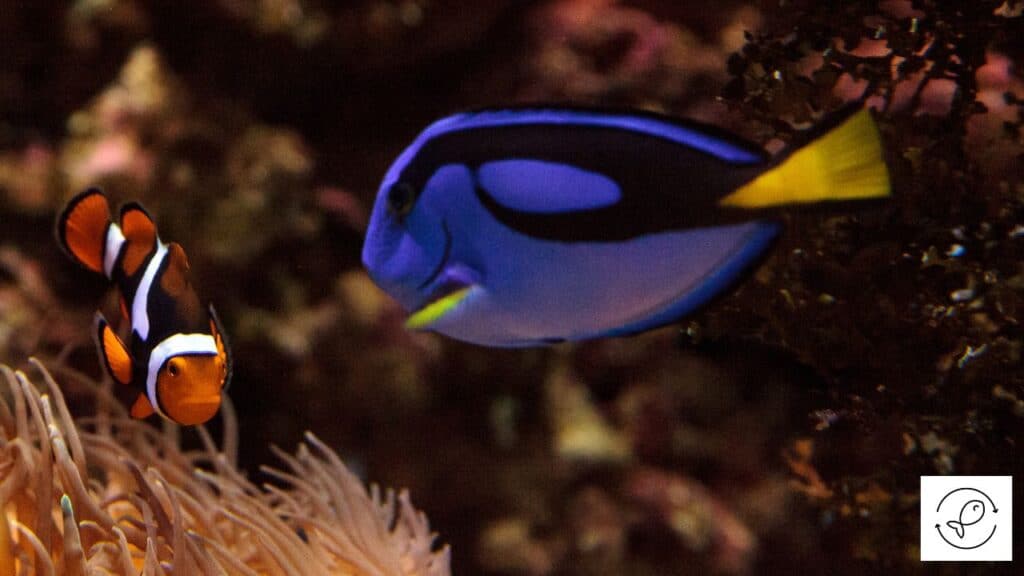Blue tangs and clownfish can live together in a reef tank. Both are native to the same region and have similar water requirements. With stable parameters, a well-balanced diet, and a suitable tank layout, you can create a stress-free environment conducive for both species to thrive.
Let’s now understand more in detail why blue tangs and clownfish can live together.
Reasons Why You Can Keep Blue Tangs and Clownfish Together
Blue tangs and clownfish are saltwater fish that are popular in the aquarium hobby.
These fish differ in size but have other similarities due to which you can keep them together in a reef tank.
Given below are a few reasons why blue tangs and clownfish can live together.
Similar Habitat
Blue Tangs can be found in the reefs throughout the Indo-Pacific region.
Similarly, clownfish are endemic to the reef or shallow lagoons of the Indo-Pacific ocean.
It means that blue tangs and clownfish are native to the same reefs and lagoons in the warm tropical waters of the Indo-Pacific ocean.
Since their geographical distribution in the wild overlaps, blue tangs and clownfish can be housed together because they need a similar environment.
Similar Water Quality
Blue tangs and clownfish require similar water conditions.
Both these fish species require water temperature in the range of 72°F to 78°F (22.2°C to 25.5°C). Similarly, a pH of 8.10 to 8.40 should be maintained in your reef aquarium for these fish to thrive.
Alkalinity is also critical in reef aquariums, and both these species need it to be 8 to 12 dKN.
They also prefer the specific gravity to be between 1.020 and 1.025.
Similar Tank Setup
Blue tangs and clownfish graze on algae from the coral reef. Moreover, both these species are active swimmers in the wild.
So they need a similar saltwater tank setup, including a coral reef, hiding places, and lots of open space for both species to swim around the reef tank.
Similar Water Movement
Water movement is most effectively described as the circulatory system of an aquarium.
It influences water quality, tank stability, and fish health.
Proper water movement is important for gas exchange, supplementing filtration, and promoting the physical and mental activities of the aquarium inhabitants.
Blue tangs and clownfish need moderate water movement inside the tank.
So it shouldn’t be challenging to create water movement that suits the requirements of both these fish.
Similar Dietary Requirements
Blue tangs and clownfish are omnivorous fish species. They need both plant matter and meat in their diet.
Due to similar dietary requirements for both these fish species, it’s easier for fishkeepers to provide a varied diet consisting of algae and meaty food.
Both these fish can be fed a diverse mix of frozen food, live food, and plant matter to satiate their dietary requirements.
Challenges in Keeping Blue Tangs and Clownfish Together
Blue tangs and clownfish inhabit the tropical waters of the Indo-Pacific region.
However, despite the similarities between these fish species, there are subtle differences.
These differences can create obstacles for these fish species to coexist.
So fishkeepers need to know and prepare themselves to handle these challenges.
Given below are some of the challenges in keeping blue tangs and clownfish together.
Tank Environment

The natural habitat of clownfish is the coral reef in the ocean.
However, they need stable water parameters to survive and can live in aquariums without a reef environment.
However, there is a difference between an aquarium and an ocean.
In the ocean, clownfish can swim away from the reef to the open waters, but they can’t do that in a closed aquarium.
On the other hand, blue tangs should be housed in environments that resemble their natural habitat.
So a correctly set up large reef tank is essential to make blue tangs comfortable.
That’s why getting enough swimming space for clownfish in reef aquariums can be challenging if it’s filled with coral, live rocks, and other things.
Blue Tangs Can Transmit Diseases
Similar to other tangs, blue tangs are also susceptible to infections.
Despite looking strong, they’re vulnerable to marine velvet and saltwater ich.
Blue tangs can also get stressed quickly when they’re moved from one environment to another.
So they easily attract parasitic or bacterial infections due to their weak immune systems.
Such blue tangs can easily transmit infections to other tankmates, like your clownfish.
This can be a challenge for your clownfish and the healthy reef ecosystem.
Blue Tangs Can Sting Clownfish
Clownfish are semi-aggressive in behavior.
However, they can live peacefully in any saltwater aquarium with suitable tank conditions.
In contrast, blue tangs can get aggressive and need perfect reef conditions inside your marine tank.
They also have razor-sharp spines covering the top and bottom of their body.
If irritated or angry, a blue tang can sting your clownfish with its razor-sharp spine.
So your tiny clownfish can get stressed living with the large-sized blue tang.
Tips To Keep Blue Tangs and Clownfish Together
Keeping different fish species in a community tank has its challenges.
However, you can keep them together by planning a proper tank setup and maintaining a conducive environment.
Given below are a few tips to keep blue tangs and clownfish together.
Well Designed Tank Layout
Blue tangs are large-sized fish that can grow up to 12 inches.
They need ample swimming space and a habitat replicating their natural environment.
On the other hand, clownfish need a hiding place and an open swimming area in the aquarium.
So remember these requirements while designing your fish tank to house blue tangs and clownfish.
Regular Tank Maintenance
Blue tangs and clownfish need similar water conditions. However, they require minimum variation in water quality.
So you must keep the water temperature, acidity, pH, and salinity constant in your marine tank.
Blue tangs are susceptible to infections.
So a robust filtration system is required to ensure there is no mess in your saltwater tank and that both fish species enjoy a healthy environment.
Well-Balanced Diet
Their diet of blue tangs mainly consists of algae as they’re omnivores.
These fish have sharp, small teeth to help eat algae off the coral reefs.
Clownfish are easy to care for and a good starter fish for new aquarists.
These fish eat almost anything, including small crustaceans, copepods, algae, larvae, and fish eggs.
Both these fish species are omnivores and need a balance of plant matter and meat in their diet.
You can feed them a proper mix of algae, frozen food, and live food to meet their dietary needs.

